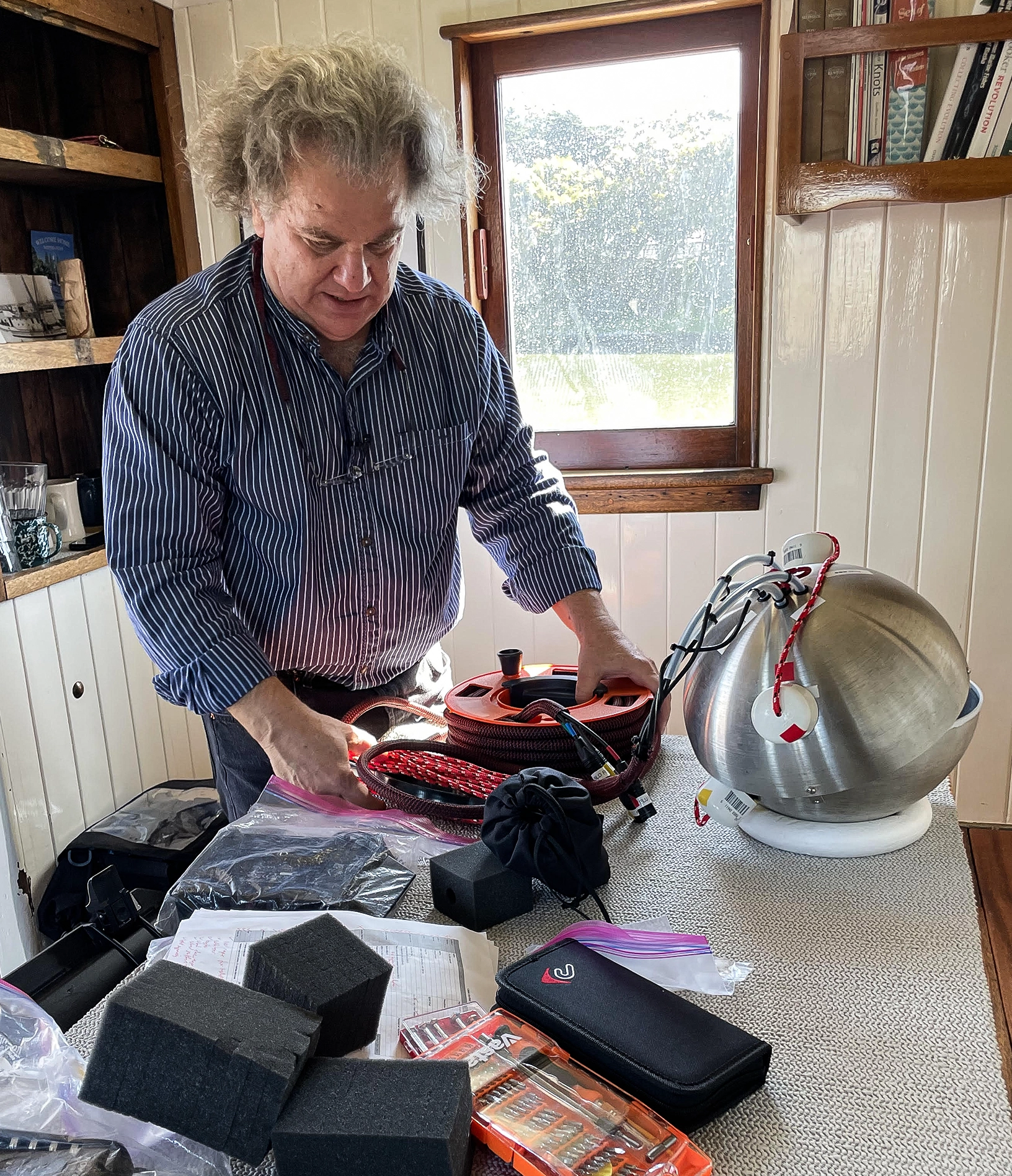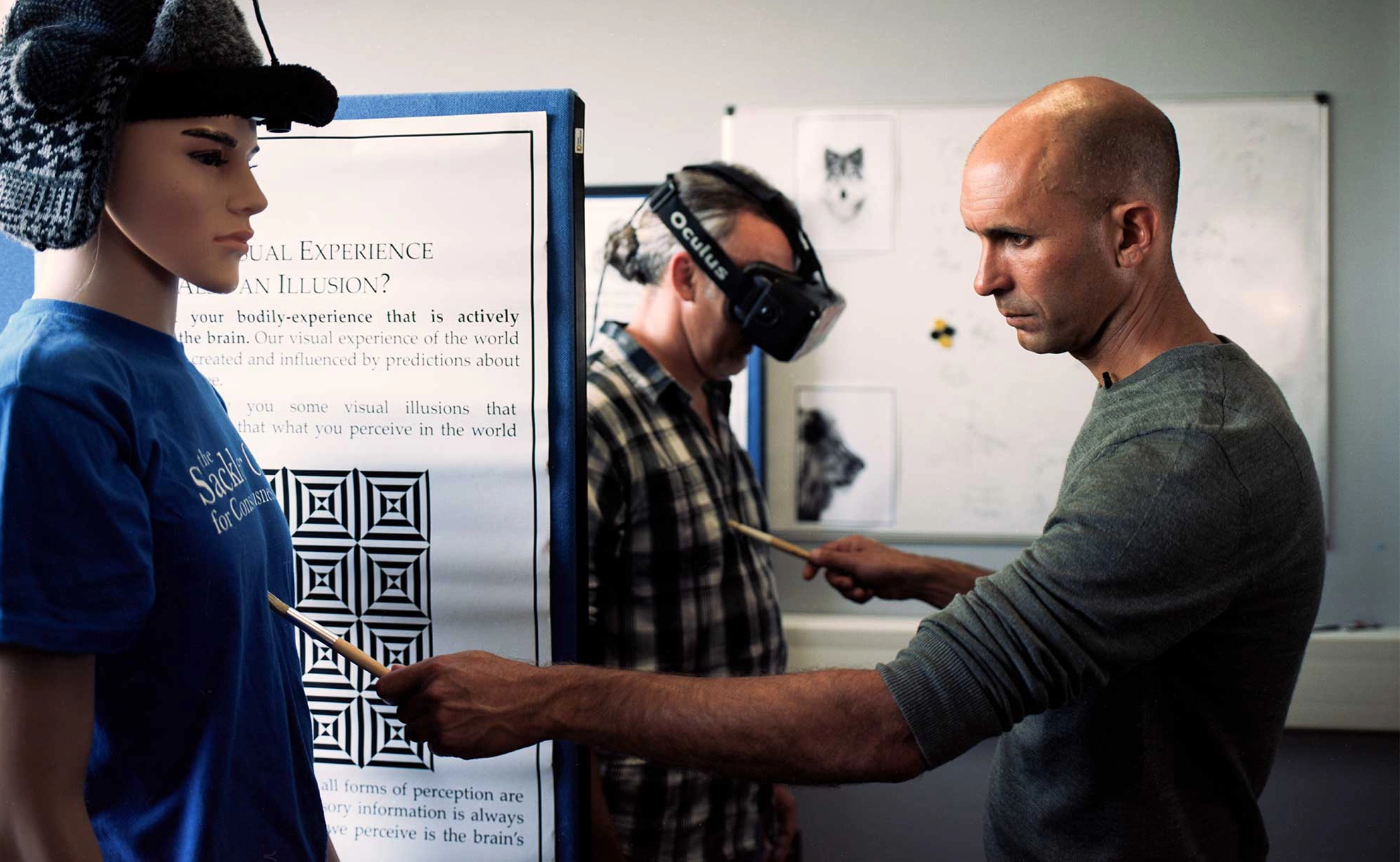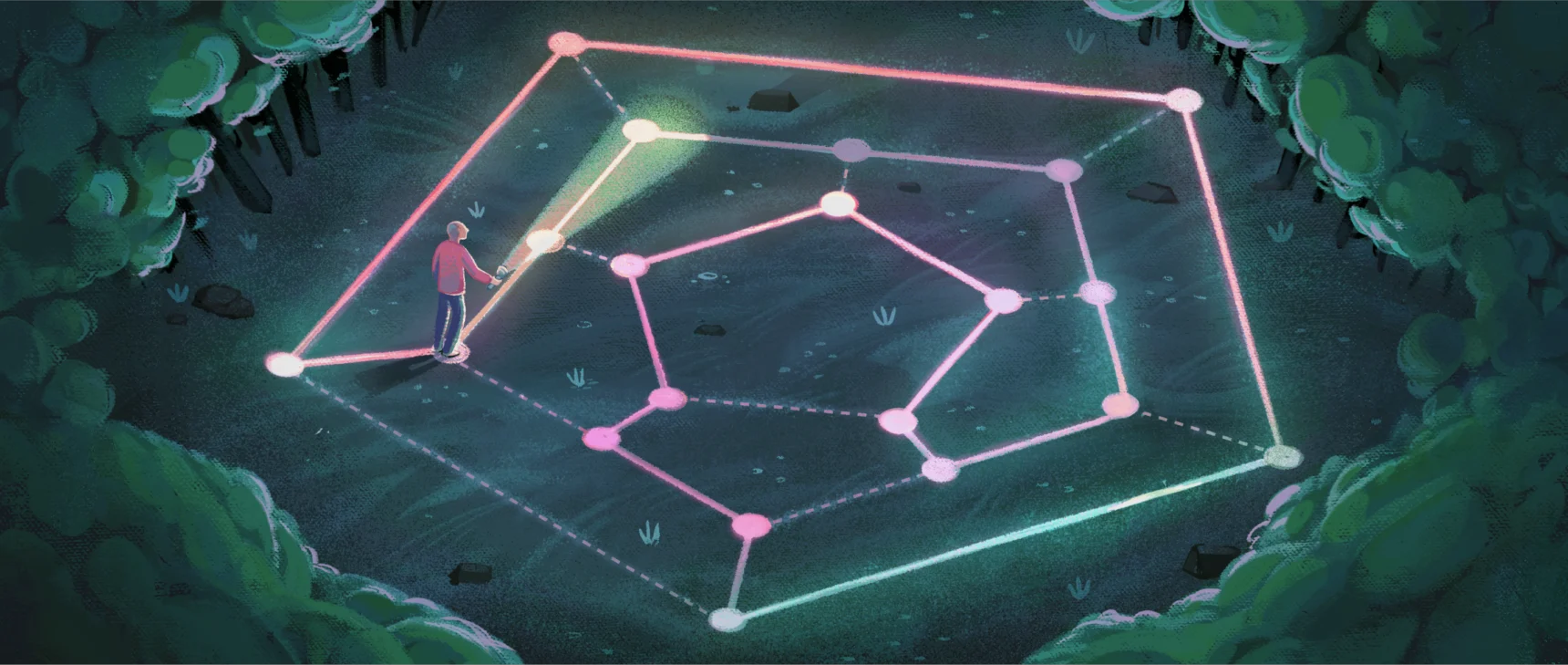The New Math of How Large-Scale Order Emerges
Introduction
A few centuries ago, the swirling polychromatic chaos of Jupiter’s atmosphere spawned the immense vortex that we call the Great Red Spot.
From the frantic firing of billions of neurons in your brain comes your unique and coherent experience of reading these words.
As pedestrians each try to weave their path on a crowded sidewalk, they begin to follow one another, forming streams that no one ordained or consciously chose.
The world is full of such emergent phenomena: large-scale patterns and organization arising from innumerable interactions between component parts. And yet there is no agreed scientific theory to explain emergence. Loosely, the behavior of a complex system might be considered emergent if it can’t be predicted from the properties of the parts alone. But when will such large-scale structures and patterns arise, and what’s the criterion for when a phenomenon is emergent and when it isn’t? Confusion has reigned. “It’s just a muddle,” said Jim Crutchfield, a physicist at the University of California, Davis.
“Philosophers have long been arguing about emergence, and going round in circles,” said Anil Seth, a neuroscientist at the University of Sussex in England. The problem, according to Seth, is that we haven’t had the right tools — “not only the tools for analysis, but the tools for thinking. Having measures and theories of emergence would not only be something we can throw at data but would also be tools that can help us think about these systems in a richer way.”
Though the problem remains unsolved, over the past few years, a community of physicists, computer scientists and neuroscientists has been working toward a better understanding. These researchers have developed theoretical tools for identifying when emergence has occurred. And in February, Fernando Rosas, a complex systems scientist at Sussex, together with Seth and five co-authors, went further, with a framework for understanding how emergence arises.
A complex system exhibits emergence, according to the new framework, by organizing itself into a hierarchy of levels that each operate independently of the details of the lower levels. The researchers suggest we think about emergence as a kind of “software in the natural world.” Just as the software of your laptop runs without having to keep track of all the microscale information about the electrons in the computer circuitry, so emergent phenomena are governed by macroscale rules that seem self-contained, without heed to what the component parts are doing.
Using a mathematical formalism called computational mechanics, the researchers identified criteria for determining which systems have this kind of hierarchical structure. They tested these criteria on several model systems known to display emergent-type phenomena, including neural networks and Game-of-Life-style cellular automata. Indeed, the degrees of freedom, or independent variables, that capture the behavior of these systems at microscopic and macroscopic scales have precisely the relationship that the theory predicts.
No new matter or energy appears at the macroscopic level in emergent systems that isn’t there microscopically, of course. Rather, emergent phenomena, from Great Red Spots to conscious thoughts, demand a new language for describing the system. “What these authors have done is to try to formalize that,” said Chris Adami, a complex-systems researcher at Michigan State University. “I fully applaud this idea of making things mathematical.”
A Need for Closure
Rosas came at the topic of emergence from multiple directions. His father was a famous conductor in Chile, where Rosas first studied and played music. “I grew up in concert halls,” he said. Then he switched to philosophy, followed by a degree in pure mathematics, giving him “an overdose of abstractions” that he “cured” with a Ph.D. in electrical engineering.
A few years ago, Rosas started thinking about the vexed question of whether the brain is a computer. Consider what goes on in your laptop. The software generates predictable and repeatable outputs for a given set of inputs. But if you look at the actual physics of the system, the electrons won’t all follow identical trajectories each time. “It’s a mess,” said Rosas. “It’ll never be exactly the same.”
The software seems to be “closed,” in the sense that it doesn’t depend on the detailed physics of the microelectronic hardware. The brain behaves somewhat like this too: There’s a consistency to our behaviors even though the neural activity is never identical in any circumstance.
Rosas and colleagues figured that in fact there are three different types of closure involved in emergent systems. Would the output of your laptop be any more predictable if you invested lots of time and energy in collecting information about all the microstates — electron energies and so forth — in the system? Generally, no. This corresponds to the case of informational closure: As Rosas put it, “All the details below the macro are not helpful for predicting the macro.”
What if you want not just to predict but to control the system — does the lower-level information help there? Again, typically no: Interventions we make at the macro level, such as changing the software code by typing on the keyboard, are not made more reliable by trying to alter individual electron trajectories. If the lower-level information adds no further control of macro outcomes, the macro level is causally closed: It alone is causing its own future.

Jim Crutchfield, a physicist at the University of California, Davis, is shown with an underwater microphone he recently designed for recording humpback whale vocalizations, to which he is applying his pattern discovery methods in hopes of decoding the causal relationships between vocalizations.
Tonje Hessen Schei
This situation is rather common. Consider, for instance, that we can use macroscopic variables like pressure and viscosity to talk about (and control) fluid flow, and knowing the positions and trajectories of individual molecules doesn’t add useful information for those purposes. And we can describe the market economy by considering companies as single entities, ignoring any details about the individuals that constitute them.
The existence of a useful coarse-grained description doesn’t, however, by itself define an emergent phenomenon, said Seth. “You want to say something else in terms of the relationship between levels.” Enter the third level of closure that Rosas and colleagues think is needed to complete the conceptual apparatus: computational closure. For this they have turned to computational mechanics, a discipline pioneered by Crutchfield.
Crutchfield introduced a conceptual device called the ε- (epsilon) machine. This device can exist in some finite set of states and can predict its own future state on the basis of its current one. It’s a bit like an elevator, said Rosas; an input to the machine, like pressing a button, will cause the machine to transition to a different state (floor) in a deterministic way that depends on its past history — namely, its current floor, whether it’s going up or down and which other buttons were pressed already. Of course an elevator has myriad component parts, but you don’t need to think about them. Likewise, an ε-machine is an optimal way to represent how unspecified interactions between component parts “compute” — or, one might say, cause — the machine’s future state.
Computational mechanics allows the web of interactions between a complex system’s components to be reduced to the simplest description, called its causal state. The state of the complex system at any moment, which includes information about its past states, produces a distribution of possible future states. Whenever two or more such present states have the same distribution of possible futures, they are said to be in the same causal state. Our brains will never twice have exactly the same firing pattern of neurons, but there are plenty of circumstances where nevertheless we’ll end up doing the same thing.
Rosas and colleagues considered a generic complex system as a set of ε-machines working at different scales. One of these might, say, represent all the molecular-scale ions, ion channels and so forth that produce currents in our neurons; another represents the firing patterns of the neurons themselves; another, the activity seen in compartments of the brain such as the hippocampus and frontal cortex. The system (here the brain) evolves at all those levels, and in general the relationship between these ε-machines is complicated. But for an emergent system that is computationally closed, the machines at each level can be constructed by coarse-graining the components on just the level below: They are, in the researchers’ terminology, “strongly lumpable.” We might, for example, imagine lumping all the dynamics of the ions and neurotransmitters moving in and out of a neuron into a representation of whether the neuron fires or not. In principle, one could imagine all kinds of different “lumpings” of this sort, but the system is only computationally closed if the ε-machines that represent them are coarse-grained versions of each other in this way. “There is a nestedness” to the structure, Rosas said.
A highly compressed description of the system then emerges at the macro level that captures those dynamics of the micro level that matter to the macroscale behavior — filtered, as it were, through the nested web of intermediate ε-machines. In that case, the behavior of the macro level can be predicted as fully as possible using only macroscale information — there is no need to refer to finer-scale information. It is, in other words, fully emergent. The key characteristic of this emergence, the researchers say, is this hierarchical structure of “strongly lumpable causal states.”
Leaky Emergence
The researchers tested their ideas by seeing what they reveal about a range of emergent behaviors in some model systems. One is a version of a random walk, where some agent wanders around haphazardly in a network that could represent, for example, the streets of a city. A city often exhibits a hierarchy of scales, with densely connected streets within neighborhoods and much more sparsely connected streets between neighborhoods. The researchers find that the outcome of a random walk through such a network is highly lumpable. That is, the probability of the wanderer starting in neighborhood A and ending up in neighborhood B — the macroscale behavior — remains the same regardless of which streets within A or B the walker randomly traverses.
The researchers also considered artificial neural networks like those used in machine-learning and artificial-intelligence algorithms. Some of these networks organize themselves into states that can reliably identify macroscopic patterns in data regardless of microscopic differences between the states of individual neurons in the network. The decision of which pattern will be output by the network “works at a higher level,” said Rosas.

Anil Seth, a neuroscientist at the University of Sussex who studies consciousness, conducts an experiment on perception.
Tom Medwell
Would Rosas’ scheme help to understand the emergence of robust, large-scale structure in a case like Jupiter’s Great Red Spot? The huge vortex “might satisfy computational closure” Rosas said, “but we’d need to do a proper analysis before being able to claim anything.”
As for living organisms, they seem sometimes to be emergent but sometimes more “vertically integrated,” where microscopic changes do influence large-scale behavior. Consider, for example, a heart. Despite considerable variations in the details of which genes are being expressed, and how much, or what the concentrations of proteins are from place to place, all of our heart muscle cells seem to work in essentially the same way, enabling them to function en masse as a pump driven by coherent, macroscopic electrical pulses passing through the tissue. But it’s not always this way. While many of our genes carry mutations that make no difference to our health, sometimes a mutation — just one genetic “letter” in a DNA sequence that is “wrong” — can be catastrophic. So the independence of the macro from the micro is not complete: There is some leakage between levels. Rosas wonders if living organisms are in fact optimized by allowing for such “leaky” partial emergence — because in life, sometimes it is essential for the macro to heed the details of the micro.
Emergent Causes
Rosas’ framework could help complex systems researchers see when they can and can’t hope to develop predictive coarse-grained models. When a system meets the key requirement of being computationally closed, “you don’t lose any faithfulness by simulating the upper levels and neglecting the lower levels,” he said. But ultimately Rosas hopes an approach like his might answer some deep questions about the structure of the universe — why, for example, life seems to exist only at scales intermediate between the atomic and the galactic.
The framework also has implications for understanding the tricky question of cause and effect in complex and emergent systems. Traditionally, causation has been assumed to flow from the bottom up: Our choices and actions, for example, are ultimately attributed to those firing patterns of our neurons, which in turn are caused by flows of ions across cell membranes.
But in an emergent system, this is not necessarily so; causation can operate at a higher level independently from lower-level details. Rosas’ new computational framework seems to capture this aspect of emergence, which was also explored in earlier work. In 2013, neuroscientist Giulio Tononi of the University of Wisconsin, Madison, working with Erik Hoel and Larissa Albantakis (also at Wisconsin), claimed that, according to a particular measure of causal influence called effective information, the overall behavior of some complex systems is caused more at the higher than the lower levels. This is called causal emergence.
The 2013 work using effective information could have been just a quirk of measuring causal influence this way. But recently, Hoel and neuroscientist Renzo Comolatti have shown that it is not. They took 12 different measures of causal power proposed in the literature and found that with all of them, some complex systems show causal emergence. “It doesn’t matter what measure of causation you pick,” Hoel said. “We just went out into the literature and picked other people’s definitions of causation, and all of them showed causal emergence.” It would be bizarre if this were some chance quirk of all those different measures.
For Hoel, emergent systems are ones whose macroscale behavior has some immunity to randomness or noise at the microscale. For many complex systems, there’s a good chance you can find coarse-grained, macroscopic descriptions that minimize that noise. “It’s that minimization that lies at the heart of a good notion of emergence,” he said.
Tononi says that, while his approach and that of Rosas and colleagues address the same kinds of systems, they have somewhat different criteria for causal emergence. “They define emergence as being when the macro system can predict itself as much as it can be predicted from the micro level,” he said. “But we require more causal information at the macro level than at the micro level.”
The new ideas touch on the issue of free will. While hardened reductionists have argued that there can be no free will because all causation ultimately arises from interactions of atoms and molecules, free will may be rescued by the formalism of higher-level causation. If the main cause of our actions is not our molecules but the emergent mental states that encode memories, intentions, beliefs and so forth, isn’t that enough for a meaningful notion of free will? The new work shows that “there are sensible ways to think about macro-level causation that explain how agents can have a worthwhile form of causal efficacy,” Seth said.
Still, there remains disagreement among researchers about whether macroscopic, agent-level causation can emerge in complex systems. “I’m uncomfortable with this idea that the macroscale can drive the microscale,” said Adami. “The macroscale is just degrees of freedom that you’ve invented.” This is the sort of issue that the scheme proposed by Rosas and colleagues might help to resolve, by burrowing into the mechanics of how different levels of the system speak to one another, and how this conversation must be structured to achieve independence of the macro from the details of the levels below.
At this point, some of the arguments are pretty fuzzy. But Crutchfield is optimistic. “We’ll have this figured out in five or 10 years,” he said. “I really think the pieces are there.”



